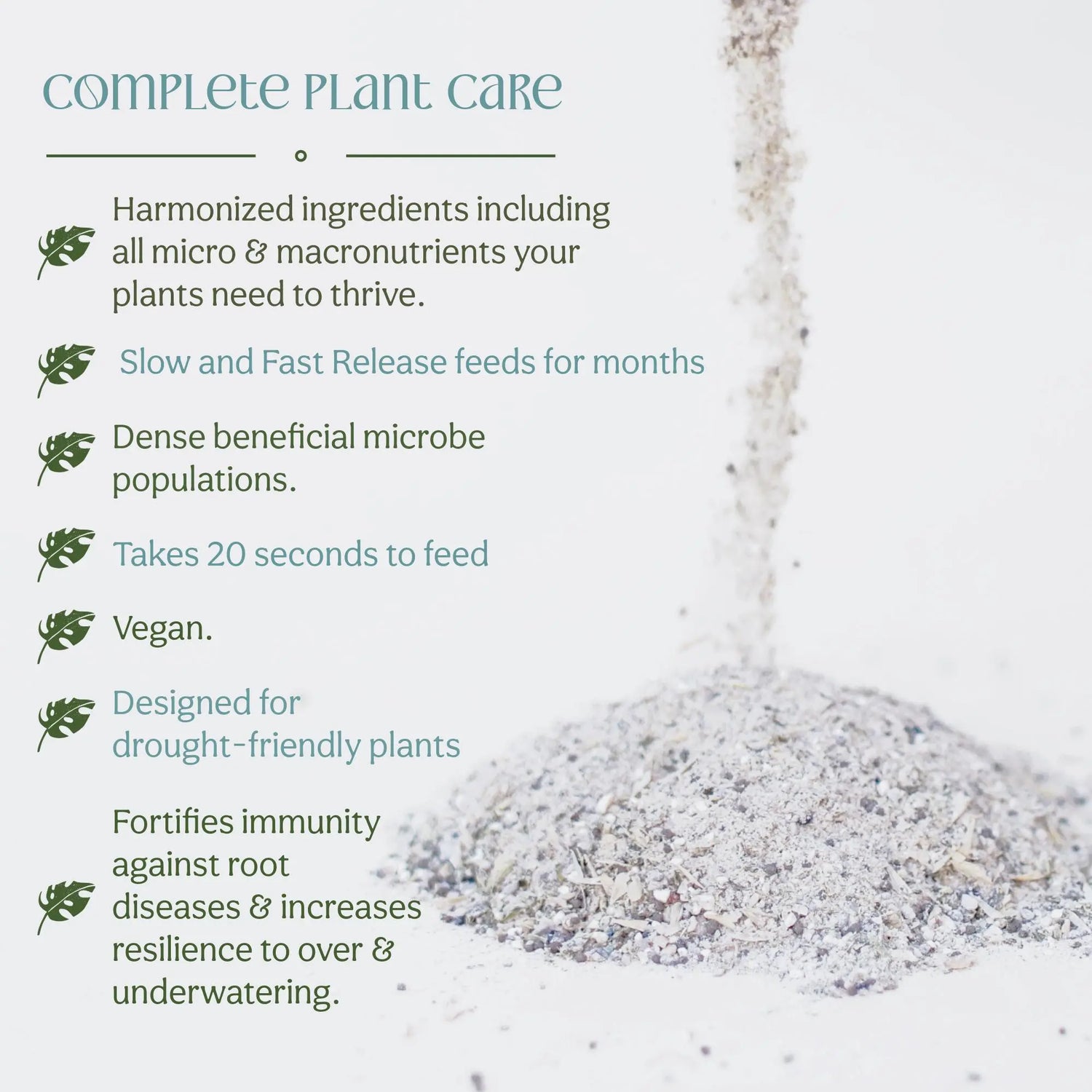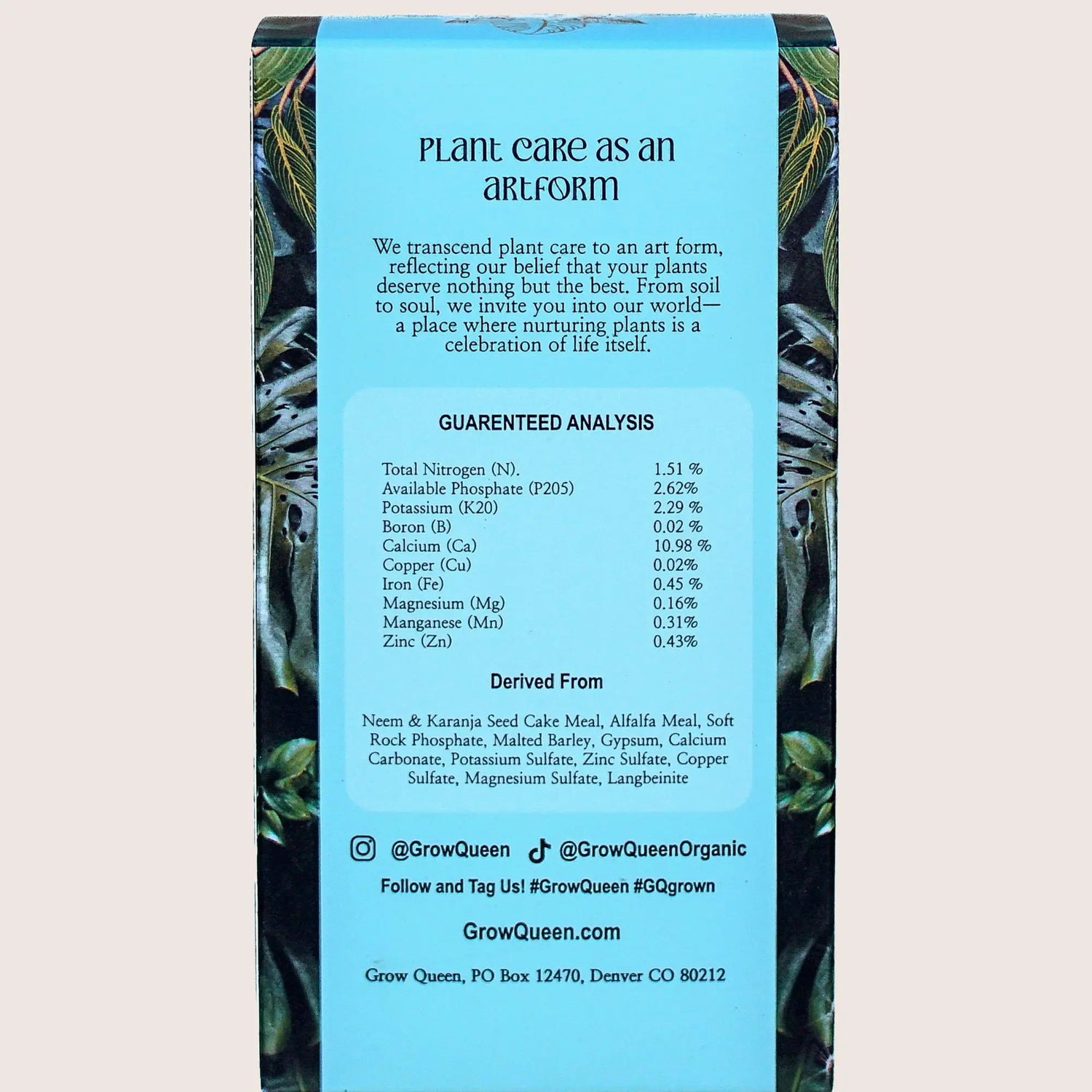Plant Care Questions
Can I over feed?
Our products are meticulously formulated to minimize the risk of overfeeding, ensuring they are both foolproof and gentle on your plants, even when applied liberally. This design philosophy helps safeguard your plants against the common pitfalls of fertilization, providing a buffer against accidental overuse. However, it's important to recognize that, like anything, excessive use over a prolonged period can lead to potential health issues for your plants.
In the event that you suspect your plant has been overfed, the best course of action is to extend the interval before the next fertilization. Allowing more time before the next application gives your plant the opportunity to absorb and utilize the excess nutrients without the added stress of further supplementation. This approach helps to mitigate any negative effects and supports your plant in regaining its balance and health. Always observe your plant's response and adjust care practices accordingly, aiming for a balanced approach to plant nutrition.
How often should I water?
Watering plants is a skill that mirrors the intricate dynamics of nature, always in motion and shaped by the seasons and environment. There isn’t a one-size-fits-all approach to the frequency or quantity of water your plants need. It hinges on careful observation, insight, and a readiness to adapt to your plants' fluctuating requirements. The most effective watering method involves doing it slowly or in several small sessions. This strategy helps avoid creating channels in the soil, which can lead to dry patches, endangering the roots and the critical microorganisms living within them. For detailed guidance on watering, consult our plant health guide.
After feeding there is a mold like growth on the top of my plants soil, what is it? Is this bad?
Observing mold or fungal growth on the surface of your plant's soil may initially cause concern, but this phenomenon is often a sign of a thriving ecosystem within your soil. The presence of these microorganisms indicates that your soil is rich in life and, consequently, that your plant is well-supported in its environment. The mold or fungus you see is part of a complex community of beneficial microbes. These organisms play a crucial role in decomposing organic matter, thereby releasing and transporting essential nutrients directly to your plant's roots.
A living soil, teeming with such microbial activity, is invaluable for plant health. These microbes are the unsung heroes of your garden, facilitating nutrient uptake, enhancing soil structure, and even protecting your plants from pathogens. The visible growth of mold or fungus on your soil is a tangible sign that these microorganisms have successfully colonized the soil medium, actively contributing to a dynamic, healthy ecosystem.
If the appearance of this mold or fungal growth is unappealing, there are simple ways to manage it without harming your soil's microbial life. Gently scraping off the surface growth and mixing it into the top half-inch of the soil can help integrate these microorganisms more thoroughly into the soil matrix. Alternatively, lightly covering the affected area with a fresh layer of potting soil or bark mulch can mask the growth while allowing the microbes to continue their beneficial activities beneath the surface.
It's important to remember that the appearance of mold or fungus is not inherently bad; rather, it's a natural part of the soil's ecosystem, contributing to the nutrient cycle and overall plant health. By understanding and appreciating the role of these microorganisms, you can maintain a more holistic and informed approach to plant care.
Grow Queen Plant Food
After feeding there is a mold like growth on the top of my plants soil, what is it? Is this bad?
Observing mold or fungal growth on the surface of your plant's soil may initially cause concern, but this phenomenon is often a sign of a thriving ecosystem within your soil. The presence of these microorganisms indicates that your soil is rich in life and, consequently, that your plant is well-supported in its environment. The mold or fungus you see is part of a complex community of beneficial microbes. These organisms play a crucial role in decomposing organic matter, thereby releasing and transporting essential nutrients directly to your plant's roots.
A living soil, teeming with such microbial activity, is invaluable for plant health. These microbes are the unsung heroes of your garden, facilitating nutrient uptake, enhancing soil structure, and even protecting your plants from pathogens. The visible growth of mold or fungus on your soil is a tangible sign that these microorganisms have successfully colonized the soil medium, actively contributing to a dynamic, healthy ecosystem.
If the appearance of this mold or fungal growth is unappealing, there are simple ways to manage it without harming your soil's microbial life. Gently scraping off the surface growth and mixing it into the top half-inch of the soil can help integrate these microorganisms more thoroughly into the soil matrix. Alternatively, lightly covering the affected area with a fresh layer of potting soil or bark mulch can mask the growth while allowing the microbes to continue their beneficial activities beneath the surface.
It's important to remember that the appearance of mold or fungus is not inherently bad; rather, it's a natural part of the soil's ecosystem, contributing to the nutrient cycle and overall plant health. By understanding and appreciating the role of these microorganisms, you can maintain a more holistic and informed approach to plant care.
Where does Grow Queen plant food come from?
All our ingredients are sourced directly from the earth, either through mining or cultivation. Our products contain a variety of natural components, including but not limited to:
- Biochar
- Neem & Karanja Seed Cake Meal
- Alfalfa Meal
- Soft Rock Phosphate
- Fish Bone Powder
- Non-GMO Soybean Meal
- Malted Barley
- Gypsum
- Oyster Shell Flour
- Potassium Sulfate
- Zinc Sulfate
- Copper Sulfate
- Manganese Sulfate
Please note that our Organic Succulent Plant Food is vegan and does not contain animal products.
List of plants recommended for use?
We recommend our Organic All-Purpose Plant Food for every plant, tree, vegetable and fruit.
For our Organic Succulent Plant Food, we recommend you use it for your Cacti, Bonsais, and of course, Succulents.
Is Grow Queen eco-friendly or ethically sourced?
Grow Queen Organic Plant Food is eco-friendly due to several key factors:
- Synthetic-Free: Most fertilizers on the market are made with chemicals that effect our planet and your plants.
- Grow Queen Enhances Your Soil: Heavy use of synthetic fertilizers can harm beneficial soil microbes, disrupting the natural soil ecosystem and leading to reduced soil health.Using Grow Queen works with the microbes in your soil to create a robust ecosystem for your plants.
- Natural Ingredients: It uses ingredients sourced directly from the earth, either mined or grown, ensuring minimal chemical processing and reducing the ecological footprint.
- Soil Health Improvement: Components such as biochar and fish bone powder enrich the soil, improving its structure and fertility, and promoting long-term sustainability of the soil ecosystem.
- Reduced Chemical Runoff: By using natural minerals and organic matter, the risk of harmful chemical runoff into waterways is significantly reduced, protecting aquatic ecosystems.
- Recycling Agricultural Byproducts: Ingredients like malted barley and fish bone powder make use of agricultural byproducts, reducing waste and promoting a circular economy.
- Low Carbon Footprint: The production and transportation of organic plant food generally have a lower carbon footprint compared to synthetic fertilizers, contributing to the reduction of greenhouse gas emissions.
When will I see results?
Once the fertilizer is watered in, unless your plant in already in peak health, you should see results in the first 24-72 hours. If your plant is dealing with issues like root rot or fertilizer burn, we recommend cleaning your plant roots and repotting it in new, clean soil. Before topping off your soil, sprinkle a scoop of Grow Queen under the last layer, and water! You should start seeing new growth and a more lively plant within 2-3 feeds.
Is This Pet-Friendly?
This is a pet-friendly product.
General Questions
Where is my package?
We ship orders within 1-2 business days of purchase. If any delays should occur we will notify you. Please check your courier's website to see if there are any delays with shipments.
Can I make a return?
Yes, you may return your plant food if it is defective. We only accept unused products for a refund.
Where do you ship?
Currently we ship to Canada, and all US state and territories.
How do I get help?
Email us at support@growqueen.com for any other questions you may have. We do our best to respond within 24 hours.










